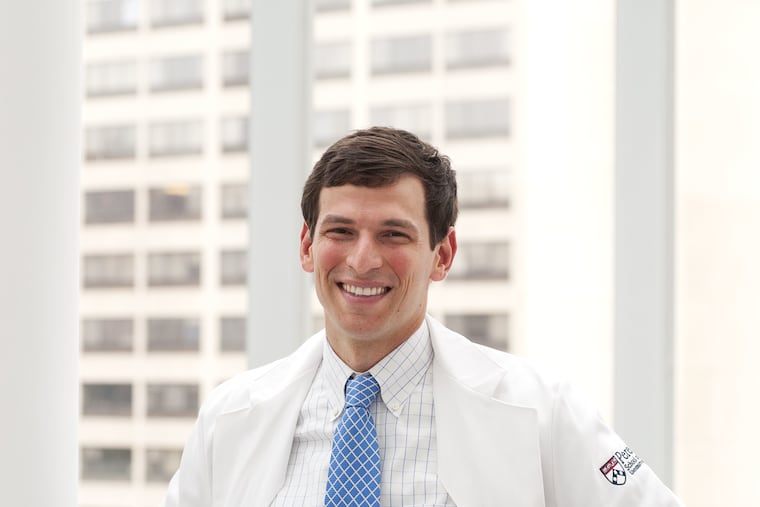UPenn doc and Castleman patient David Fajgenbaum pens new memoir
Don't sit back and take medicine's word on your disease. Chase your own cure, advises a Penn doctor in a new memoir.

He’s a doctor — and he’s also a patient.
David Fajgenbaum, a physician and professor at the University of Pennsylvania’s Perelman School of Medicine and a sufferer of Castleman disease, this month releases a new book, Chasing My Cure (Penguin Random House, $27), a memoir that traces his terrifying symptoms, self-driven diagnosis, and unlikely treatment with an off-the-shelf drug.
It’s a harrowing story of his diagnosis with the rare idiopathic, multicentric Castleman disease during medical school. Once a college football star in peak shape, Fajgenbaum nearly died five times, dropped out of and returned to medical school, and fought for his health through the creation of a fellow disease-sufferers’ network. He then pursued an MBA at Wharton, and while still in business school, performed laboratory research at the University of Pennsylvania on his own case.
The takeaway? The traditional approach of waiting for cures no longer works — that is, relying on doctors and big pharmaceutical companies to decide a cure is worth the funding of research.
Instead, Fajgenbaum pioneered the use of crowdsourced data for the study of disease, and his compelling book explains how he started first by polling other patients with symptoms of Castleman disease, a group of poorly understood inflammatory disorders that vary from a single enlarged lymph node to life-threatening multiple-organ failure. From there, he began tinkering with possible treatments.
“There are 1,500 drugs available that have been approved for treating something, and 7,000 diseases without any approved drugs. There have to be some cures available that are already out there — I’m living proof,” Fajgenbaum said in an interview.
#TBT to these before and after pictures. From playing football at Georgetown to the day I got out of the hospital after 6 months of organ failure. How do you find HOPE when it feels like all hope is lost? #ChasingMyCure Pre-order your copy today - https://t.co/Yxy9LIItgg pic.twitter.com/LzjXO1oPhv
— David Fajgenbaum, MD (@DavidFajgenbaum) August 22, 2019
Through trial and error, he researched his own symptoms and found clues to a potential treatment for Castleman disease that was already available to treat organ transplant rejection — a drug called sirolimus. In the meantime, he also founded the Castleman Disease Collaborative Network (CDCN), a template for other crowdsourced cure-research groups.
“The point is we don’t know which drugs will work,” he said.
» READ MORE: Meet the South Jersey volunteer who fosters injured, pregnant, and newborn pets
Currently, a clinical trial of sirolimus is enrolling patients at Little Rock, Ark., and at Penn hospitals. The clinical trial will enroll 24 patients over the next year.
The CDCN group, founded by Fajgenbaum and longtime friend and physician Frits van Rhee of the University of Arkansas, has two goals: to uncover how the disease works and to establish a global network to improve biomedical research.
Fajgenbaum hopes the book provides a road map for others with so-called “orphan” diseases — where sufferers and patients can band together to raise money and chase their own cures.
“We’ve looked at 26 patients with my disease, and it’s a rational drug to try in others,” he said.
His aim? To replicate the do-it-yourself process for other rare diseases.
Crowdsourcing treatments is now a nationwide movement that’s inspired two new television shows: Chasing the Cure, hosted by Ann Curry, airing this fall on TNT/TBS networks, and Diagnosis on Netflix.
What about those who suffer from other rare diseases? Start by contacting a sympathetic research hospital or outfit such as Penn’s Orphan Disease Center.
That’s what Allison Weiss Brady and the nonprofit Gene Spotlight did, raising $250,000 over five years for Penn research into lysosomal storage disorders; rare orthopedic conditions, including Gaucher, Pompe, Fabry, Mucopolyssacharidosis 1, 2, & 3; and rare cancers.
“There is currently a shift underway in how rare diseases are viewed,” said Brady, cofounder of Gene Spotlight, which raises money for rare disease medical research at Penn.
“These conditions are often referred to as ‘orphan diseases’ because drug companies have historically not been interested in adopting them to develop treatments, due to a smaller number of patients. But with the onset of successful rare-disease treatments that have recently hit the market, pharmaceutical companies and donors are now realizing that their money is well-spent in supporting rare-disease medical research and drug development,” she said.
» READ MORE: These metal ‘detectorists’ find lost rings — and memories
Fajgenbaum’s story, she adds, “shows that with attention and research, treatments and cures for rare diseases are possible in a relatively short time frame.”
In addition to his other work, Fajgenbaum is also associate director for patient impact at the Orphan Disease Center.
He also recommends patients contact Global Genes, a “great organization that focuses on clinical trials and research on treatments and cures.”
While it doesn’t offer patient care, Global Genes functions “as a sort of clearinghouse of information for rare disease sufferers,” he said.
Global Genes this month will host the Rare Patient Advocacy Summit, a two-day program with TED-style keynotes and educational content ranging from the latest in care to cutting-edge research and therapies.
Locally, Fajgenbaum will appear at Philadelphia-based College of Physicians for a book signing and event on Tuesday at 6:30 p.m. The cost is $10.
He will also speak in October at a Global Genes’ event in Philadelphia, exploring what a “DIY" collaborative research approach is and how can it help with patient organization-led data collection. His speech will focus on attracting more doctors and researchers, crowdsourcing to accelerate data collection, and exerting control over research.
For now, he’s in remission on sirolimus — and is happily married and a father to a baby girl.
“I had started out trying to save my own life,” he said. “Now I’m working to help save many others.”